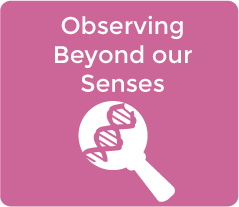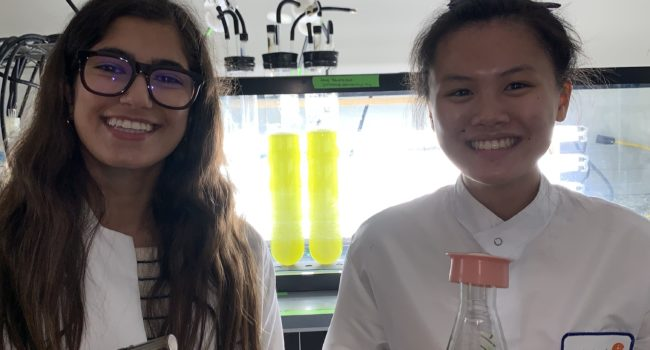Lesson 3 – Inferences from Proxy Variables-Mock AFM
 see.isbscience.org/observing-beyond-our-senses/lesson-3-inferences-from-proxy-variables-mock-afm/
see.isbscience.org/observing-beyond-our-senses/lesson-3-inferences-from-proxy-variables-mock-afm/

Course: Integrated Science, Physics, Biotechnology and/or STEM courses
Unit: Measurement, Scientific Process, and Instrumentation Design
See Standards Addressed for all NGSS, WA State (Science, Math and Literacy), and NOAA Ocean Literacy Education Standards Connections. In addition to the aligned objectives linked above, for this lesson, here is a breakdown of:
- Observation is the skill of recognizing and noting some fact or occurrence in the natural world. Observation includes the act of measuring.
- To infer is to arrive at a decision or logical conclusion by reasoning from evidence.
- Scientists use observations to make inferences.
- Additional information can improve the validity of inferences.
- Proxy variables can be used to make observations.
- An Atomic Force Microscope (AFM) uses repulsive force as a proxy variable to make observations of surfaces at the atomic scale. Processing the data with of visualization software, scientists infer surface structure from these observations.
- Increased resolution can provide additional information.
- Design solutions involve tradeoffs.
- Make observations and generate inferences about differing types of data.
- Use “touch” data to draw an unknown object in a bag.
- Make inferences about the identify of the object from the drawings.
- Use a mock Atomic Force Microscope (AFM) to infer surface structure from “touch” data processed with Excel into a 3D graph.
- Brainstorm ways to improve the design of their mock AFM & evaluate the trade-offs.
- Evaluate the limitations of utilizing proxy variables to take measurements.
- Evaluate the limitations of observation to infer patterns or make predictions.
Please note: There are additional materials needed for this lesson. The paper bags with items for the warm up activity should be assembled and taped shut before class. The mock AFM boxes can be assembled ahead of time, or students could assemble them in class. If assembled during class, the surfaces should be inserted into the boxes without students seeing them so have students trade boxes or one class make them for use in another class. Students will also need computer access (one per group) to plot the mock AFM data on the premade Excel file. See Making the AFM Teacher Directions Materials Not Included (for ~25 students, ~8 groups of ~3): Slides 14, 15, & 16 Introduce the concept of using “touch” data to make observations at scales too small to see with the human eye. Slide 17 introduces the Atomic Force Microscope. Since atoms repel each other, we could probe a surface with a very fine tip and record the feedback from the changing topography. Repulsion data from dragging a small ‘cane” across a surface is visualized with computer software so that inferences about atomic structure can be made. Slides 18 & 19 show examples of data used to visualize the hexagonal structure of carbon in graphite and the repeating “steps” in gold. Handout mock AFM boxes (or have students assemble them in class) and marked probe sticks. The provided surfaces should be hidden inside (box opaque and lids taped down) (slide 20). Instruct student groups that they are NOT to open the box. Demonstrate how students will use proxy “touch” data collected as probe stick measurements to infer the surface structure. To help interpret the data visually, the measurements can be directly entered into the premade Excel File Lesson 3 3D Plot Mock AFM: using the Sheet named Student Data Gross. Guiding Questions for a whole class discussion regarding the processed data: While students are discussing the effect of the changes, the teacher should be circulating to change out the screen (graph paper with smaller squares) for the fine data collection, ensuring that students do not see into the box.
Based on how much time you have available, choose a career-connected activity below. In each case, recap what your students just learned in the lesson to the activity. outside of class Additional Information Example interview questions for Dana: What skills did you already have when you started this project? How did you develop the other skills that you did not acquire through the communications major?
Instructions
Instructional Activities:
Vanilla for scent
-Paper lunch bags (per student)
-Collection of items of similar size and shape (pack of gum, eraser, used (EMPTY) lighter, USB drive, 9Vbattery). See powerpoint slide #10. (1 per student)
-Probe sticks (one per group) that have been marked in 0.2cm resolution (wooden skewers from the grocery store work well).
-Rulers (one per group)
-AFM box (1 per group)
-marking pen(1 per group)
-1cm x 1 cm graph paper (and somewhat smaller 0.5 cm x 0.5 cm if completing the ‘fine’ resolution data collection).
-box about the size of a shoe box (one per group)
Teacher Notes: Student answers may vary. One key idea that students should recognize is that some means of achieving greater resolution could provide additional useful data. Ask students to extrapolate what new data could be revealed by shrinking the tip size of the probe stick within the grid they just used or conversely to use their current tip size to take measurements at smaller and smaller grid intervals (0.05 cm x 0.05cm, etc. ). Drawing out the extrapolations on whiteboards in groups can help them visualize the effect of the change.
Have students repeat the process using the fine data collection screen (0.5 cm intervals) and the Sheet named Student Data Fine within the same Excel spreadsheet. Once the fine data collection & graphing is complete, collect the boxes and set out the surfaces for students to view.Career Connection
A homework/
B 5-10 minutes in class
C half of class period (~25 minutes)
D entire class period (~50 minutes)
Give handout for students to watch Dana's video and answer questions at home as homework.
A + Brainstorm on interview questions for Dana using a whiteboard or projector.
A+ Have students imagine a job like Dana's that works with sensors and proxy variables. Students prepare written explanations of the proxy variable, and the education necessary to do this work.
C + Have students prepare a set of interview questions for the person/job they’ve identified or described in C. This could start with students taking 3 minutes on their own, then pair-and-share, then share to class and evaluate questions.
Assessment
Resources
Excel: Lesson 3 3D Plot Mock AFMExtension Activities






